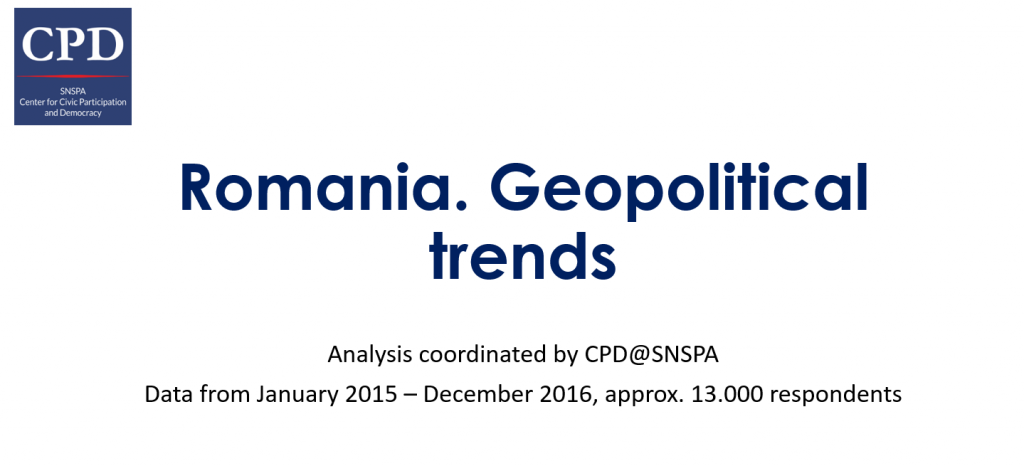Summary


We have collected the results of all polls conducted between January 2015 and December 2016 by CSCI/OR (18 polls, 12,887 respondents) and we have divided them into five periods, as follows: 1.Semester I 2015 (Jan– Jun). 4505 interviewees. Immediately after the presidential elections. The honeymoon of president Iohannis, who had gained the populations’ trust and was cohabiting with the Ponta Cabinet. 2.Semester II 2015 (Jul-Dec). 2487 respondents. An interval affected by the erosion of the president’s public trust ratings, conflicts between the two palaces, which concluded with the Colectiv tragedy, the resignation of the Ponta cabinet, and the formation of the Ciolos Cabinet. 3.Semester I 2016 (Jan-Jun). 2319 respondents. The honeymoon period of the Ciolos Cabinet. It concludes with the local elections. 4.Semester II 2016 (Jul-Nov). 2786 respondents. Affected by the electoral campaign preparations, as well as by the transformation of the USB into USR, concluding with the PSD’s victory in the general elections. 5.Parliamentary elections (Dec). 780 respondents. This database contains answers from the final days of the electoral campaign and immediately after the elections, before the formation of the Grindeanu Cabinet.
MAIN FINDINGS
Romanians are, still, very much pro-Western. Our analysis from 2016 demonstrates that, while Romanians feel protected from a military point of view, other factors which are more susceptible to change influence the public’s feelings and agenda. The US perceived influence is weaker than the EU influence, and we tested both current and desired levels.
- (1) Romanians temper their optimistic tone about EU and NATO membership. Several survey sources indicate a stop of the upward trend regarding these options. Although Romanians in their majority remain pro-Western, there is no more room for growth for these numbers. In addition, the number of Euro-skeptics and Neutrals about the pro-Western orientation is increasing.
- (2) There are more pro-Western Romanians than any other category, and the pro-Russian public is a minority. But although there are more pro-Western Romanians than pro-Russia ones, pro-Americans do not outnumber the neutral public. The neutral public is not enthusiastic about the US, but it appreciates the US more than Russia – their vulnerability is not in regards to the relationship with US or Russia, but their regard to Western democratic model and their dependency on the success of the European project.
- (3) The pro-US public is about one-third of the population and the pro-Russian public reaches a maximum of 17-18%. It is interesting to note that the pro-Russian public is not isolated, uneducated and old – on the contrary, it is younger than their pro-American counterpart, more concerned about online communication and unexpectedly well-positioned in terms of education and economic status.
Data from last December shows that the right-wing public is more pro-Western than the left-wing public and that differences are significant (enthusiasm towards the West of the right-wing public is larger by +20%). USR voters are the most pro-West voters, but PNL numbers are close.
- At the same time, it is important to note that we do not see among the left-wing voters a larger attraction towards Russia, as compared to the right-wing public. PSD voters/sympathizers reject a closer connection to Russia to the same extent as other respondents, consequently, we cannot establish a demarcation along this line.
- The public which is somewhat more open to Russia (a minority in fact) comes from the area of the common public (which registers the same trust in both the right and the left), as well as from the ranks of the undecided left-leaning voters.
- The PNL electorate is balanced pro-EU and pro-US. PMP is much more pro-US. USR is much more pro-EU (being at the same time the right-wing public most open towards Russia).
- On the left, ALDE is balanced (resembling the PNL), whereas the PSD public is more pro-US.
- The influence most strongly perceived is from the EU (in economy, culture, and media), and then from the US (in the military only). The PNL public wants a larger US influence than the average, whereas the PSD voters want a lesser level of foreign influence than the average (hence the resonance to the nationalist discourse).
- Media consumption – the right-wing public gets its information from the TV (51%) and online (16%), whereas the left-wing public gets its information from TV (76%) and online (4%!). It is noteworthy that the common public (which trusts both the left and the right) contains the smallest proportion of TV and online influence, regarding discussions with friends and acquaintances, or reading the local media, as more relevant than major media outlets.
- The people consuming more online media want a larger influence of the US in Romania.
- A final remark – intolerance towards gay people does not differ based on the political orientation (the right-wing public is only marginally more tolerant).
For the entire study, ask CPD team – office@civicparticipation.ro
